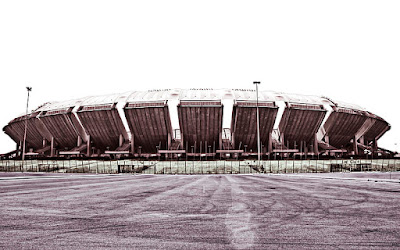Yesterday, with Gabriele Gravina's confirmation that Italy would bid to host either Euro 2028 or Euro 2032, the irony was not lost on me. The FIGC president's announcement is in sharp contrast with the reality of football in Italy, particularly the condition of the stadiums. It has been over 30 years since Italy hosted the World Cup, which is the last time there were any significant renovations or stadiums built in the entire country. It is hoped that being awarded such an important tournament would be the impetus for local authorities to stop blocking new stadiums from being built. But why would UEFA even trust that Italy could get the job done and be worthy hosts when there are so many better existing infrastructures in other countries? This is one of the reasons why Italy can't have nice things.
 |
| Clinging to history is making Italian football part of history |
Within Gravina's statement was the quote "We'll do it in serious fashion, because there is great desire for renewal of infrastructures, for example in Florence, Cagliari, Bologna, and Bari." Renewal of infrastructures? His idea of hosting the Euro Tournament involves renovating 32+ year-old stadiums over the course of the next six to ten years? I know Italy is famous for its ancient history, but one of the biggest stumbling blocks that keeps Serie A from being competitive with the other big leagues is its serious lack of new stadiums built in this century. Renewing a stadium in Bari, where there is currently not even a Serie A team, is not going to solve anything. Italy desperately needs to build new stadiums that are modern and sustainable.
According to sports crowdfunding platform Tifosy, there are currently approved or under construction over €2.5 billion worth of new stadiums being built in Europe. Not a single one of those is in Italy. That alone speaks volumes about a country that thinks they can host a major football tournament.
Milan know very well how difficult it is to try to get a stadium built in Italy. In 2013, Barbara Berlusconi began the process of planning a new environmentally friendly 48,000 seat stadium and complex exclusively for AC Milan, including a hotel, a football academy, and more. Two years of planning and trying to find appropriate sites, as well as investing a lot of money in design and other costs, and the bid for the site next to Casa Milan was won in 2015. This was a huge hurdle in the process, and it was hoped that the stadium would have been ready by the 2018-19 season. But Silvio Berlusconi cut the project completely after haggling with the landowners about certain construction costs, and also as he began entertaining offers to sell the club.
 |
| Remember this? |
The only club in Italy to have successfully built a new stadium since the 1990's is Juventus, who replaced the Stadio delle Alpi, built for the 1990 World Cup, with a brand new, state of the art stadium and attached shopping center in 2011. They have since added a museum and medical facility as well. Juventus are one of only a couple of clubs to even own their own stadium at all. The economic advantages of stadium ownership are widely attributed to Juventus winning the Scudetto in 2012, and eight more consecutive titles after that. They have also been able to compete with other European clubs more successfully due to the financial power that comes with owning a modern stadium and all of its amenities.
The San Siro originally opened in 1926 as a 35,000 seat stadium. It was restructured and expanded in 1955 with the famous spiral ramps, and then again in 1990, when the roof was added and seating expanded to 85,000 for the World Cup. Most recently, there were some improving of facilities to host the 2016 Champions League final. But after some unusual movement in the upper ring, architects found that it is no longer viable to be upgraded. This led to the joint project between Milan and Inter to build a new stadium to replace the legendary San Siro that was announced in January of 2019, hoping to be ready in time for the 2022-23 season.
 |
| This design was announced 3 years ago and should be opening this fall, but is still only an illusion |
In another country, maybe that would have happened. But Italian bureaucracy kicked in to high gear, with road block after road block being put up. How many times in the past three years have we heard public discussion about tearing down the San Siro? In fact, as a compromise, the two architectural firms competing for the bid had to go back to the drawing board and redesign their projects to include keeping part of the San Siro in their designs, incurring more expenses and delays for the project. Yet Mayor Sala is once again entertaining public debate on the matter.
Just one more obstacle after so many others, including a year ago when Inter's poor finances put the project on hold. Or another delay in October, after Sala was re-elected and had promised to push the stadium forward, yet has since been "listening" to all sides. Here we are in 2022, the year it should have been completed, and still no groundbreaking date in sight because the issue of tearing down the San Siro is up for debate yet again. But hey, at least after four years of working on this, we finally have a project officially chosen.
 |
| Plans to retain part of the San Siro in the new project are still collecting dust |
The other day, Italian news site Calcio e Finanza asked the question, "Is the NFL the Example to Follow?" Their premise was based on finding out that the cheapest tickets available for the NFL's NFC Conference final on Sunday (or "semifinal" as they refer to it) were $526. Tickets range from that amount up to $9,000. Per ticket. Tickets for the Super Bowl two weeks later begin at $5,000 per ticket. Keep in mind that Italian fans boycott matches when tickets each cost €40, or about $45 U.S.
Italians see these figures and think that the 'American business model' is the future of football. As if gouging Serie A fans for money they don't even have to sit in old stadiums without any concessions or amenities will make them rich. They literally can't even fill the stadiums at current prices. But as they reluctantly mentioned in the article, the NFL "semifinal" game is also being played in a cutting edge $6 billion stadium that is not even two years old. They don't understand that the ticket prices exclude a huge majority of the fans of both the Los Angeles Rams and the San Francisco 49ers from experiencing such a big match. Or that sponsorships gained from competent marketing are what really makes the league and franchise owners successful.
 |
| When Italy has $6 billion stadiums, they can charge ridiculous ticket prices |
The 'American business model' is based on closed leagues without competition that have strict financial models. Teams are franchises of the NFL, for example, and an owner would never get away with playing in archaic stadiums like in Italy. The marketing prowess of the NFL is unique because it is the only American football league of its level in the world, not to mention that the NFL organization is actually run like a business. Compare that to Serie A, for example, which is competing with four other top European football leagues and countless smaller leagues around the world, and is run by a bunch of superstitious, greedy old men who cannot agree on anything.
Particularly with so many foreign owners who actually want to invest in infrastructure, the lack of new stadiums in Italy is inconceivable. The building of new stadiums is impeded by local agencies and is prohibited by everything from citizens' concerns, not wanting to let go of history (such as the San Siro,) to things like protecting a specific species of frogs, as happened with Roma's stadium plans. Even if they solved those problems, then it would be things like overscheduling facilities, agreeing on television rights or addressing concerns like racism or stadium safety. These are all massive issues for Serie A that they are incapable of addressing and keep Serie A in the Dark Ages.
 |
| Renovating a 32 year-old 58,000 seat stadium for a Serie C team is the FIGC's idea for EURO 2028/32 |
The problems that keep Italian football in the dark when it comes to financial success are extensive. Perhaps the most obvious is that they honestly believe that winning a bid to host a major tournament will solve their profuse and deep-seated problems, let alone make them competitive with other leagues and nations. Looking to a country that has built sports leagues that are globally unique, in a nation built on excess, where the almighty dollar excludes more fans than it includes is not the answer. The FIGC should be looking at things that make Serie A unique, such as the passion, the coreo and fans, and the beautiful playing style, then building financial success off of that. Instead, they keep doing all of the wrong things that make Serie A unique, and that is why Italy can't have nice things.
This post inspired by the music of Garbage's "Empty"

